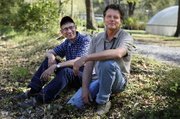
Snail sleuthsC of C Researchers find Lowcountry species By Bo Petersen
The Post and Courier
Saturday, April 3, 2010
JOHNS ISLAND -- The snail just didn't look right. It should have been just another Physa acuta, another of those tadpole snails that can be found nearly anywhere in the world. This slimy, tick-sized critter was a little skinny, its shell a little dark. But tadpole snails tend to vary in how they look, and the College of Charleston biology research team had gone to the sod farm of Johns Island to look for tadpole snails to use in a study about genetic variations across waterways.
So graduate student Amy Wethington picked a sample of them out of the muddy ditch. When graduate student John Wise, an anatomy specialist, got his first glimpse at the shell, it looked a little off. When Rob Dillon, biology associate professor, and one of the leading "snail guys" in the field, saw the snail, he said, "Gee, this one looks a little odd." But the similarities were too strong, the snails had to be Physa acuta. Wethington was so sure that she used it later for DNA sequencing work at the
University of Alabama, and got another surprise. The sequencing kept falling out
of the category for the snail. Her colleagues shook their heads and told her,
you've got a different species. "I didn't believe them. The snails really didn't pop out at us as that much
different," she said. So she turned to Dillon, a breeding specialist, for the
"mule test." And sure enough, mated to types of Physa acuta, the little critters
produced sterile offspring. Wethington had found her own species of snail. When was the "aha!" moment? That's the funny part. Wethington pulled those snails out of the ditch in 1989. The report written by the three researchers was just published in The Nautilus, a peer-reviewed biology journal dedicated to mollusks. "It's snail research," Dillon said with a laugh. "There is no 'Aha!' moment. It was a grad-u-al, grad-u-al, agonizingly grad-u-al, an inexorable, excruciating movement to this conclusion." How slow was it? Wethington is now an assistant professor of biology at Chowan University in North Carolina. Wise went on to teach at Georgetown University and the University of Southwestern Louisiana and was curator for 10 years at the Houston Museum of Natural Science. He now runs the Garden Wise gardening center on, oddly enough, Johns Island. The work moves, as Dillon said, at a snail's pace. But the three now have attained science immortality as discoverers of a new species. Wethington wanted to call the critter Physa fossa, after the Latin word for ditch. The others said that was too cute. The snail is Physa carolinae. How does immortality feel when you owe it to a snail? "Wonderful," Wise said. "It's gratifying. There's so much out here that we just have overlooked. We send scientists all over the world, and we don't know what slugs are under our trash can. We need to understand what's in our own backyard," Dillon said. "I would have never thought I'd like snails," Wethington said. But she loves research. "They're easy to catch. They're easy to take care of in a lab. They reproduce like crazy, and there's a lot of variety. We even found an albino." Reach Bo Petersen at 937-5744 or
bpetersen@postandcourier.com. |

